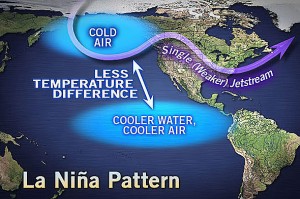 THUNDER BAY – If Accuweather is right, a cold and snowy winter for much of Ontario is to be expected. It is expected to be much colder over Western Canada as well. The cause is expected to be effects from La Niña. Accuweather’s Grace Muller states, “La Niña is a phenomenon that occurs when sea surface temperatures across the equatorial central and eastern Pacific are below normal. The phenomenon often produces extreme cold outbreaks across western Canada during the winter due to the influence it has on the jet stream. Snowfall tends to be greater across Ontario and Quebec in a La Niña winter, while there’s almost always unusually dry winter weather along the West Coast during weak and moderate La Niñas”.
THUNDER BAY – If Accuweather is right, a cold and snowy winter for much of Ontario is to be expected. It is expected to be much colder over Western Canada as well. The cause is expected to be effects from La Niña. Accuweather’s Grace Muller states, “La Niña is a phenomenon that occurs when sea surface temperatures across the equatorial central and eastern Pacific are below normal. The phenomenon often produces extreme cold outbreaks across western Canada during the winter due to the influence it has on the jet stream. Snowfall tends to be greater across Ontario and Quebec in a La Niña winter, while there’s almost always unusually dry winter weather along the West Coast during weak and moderate La Niñas”.
Muller also says, “Because the Great Lakes are running warmer than normal, the areas around it will have a greater amount of lake-effect snowfall as very cold air wraps in behind those Colorado lows”.
Exacta Weather in the UK has stated, “La Niña cools the equatorial seas of the Pacific and was one of the strongest on record during 2010/2011. Less warm air rises during La Niña conditions with a cooling influence on the atmosphere that has big implications on global climate and global weather patterns. The changes in global weather patterns come from air pressure changes in atmospheric cycles called the North Atlantic Oscillation (NAO) and Arctic Oscillation (AO).
“The latest National Oceanic and Atmospheric Administration (NOAA) update suggests neutral conditions ahead, but a negative Pacific Decadal Oscillation (PDO) may yet suggest otherwise. The PDO is a pattern of Pacific climate variance that recently switched to negative (cold) and will remain that way for the next two to three decades. It is likely that La Niña will return more frequently during this time period as a negative PDO results in stronger La Niña (cooling) and weaker El Niño (warming) episodes.
“Low solar activity is also a primary driver of atmospheric cycles that influence blocking activity patterns/ridges”.
For much of Northwestern Ontario, for the next three months, Environment Canada has forecast “Normal Temperatures”.
Image from Accuweather.
